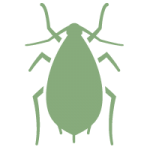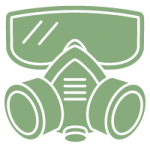Control Methods: Treatment methods may vary depending upon the level of infestation, the offending pest species and the product which has been contaminated. These methodologies range from pheromone monitoring, contaminated food removal, space spray treatment and/or fumigation.
Beetles
Behaviour
There are many species of stored product beetle and are commonly a pest of cereal products e.g. flour, bread, it is an indiscriminate eater and will feast on a wide variety of products from furs and leather to spices and even pharmaceutical products.
With such a varied diet it is found in a wide range of places, as it will survive on any type of food. These insects are winged but tend to travel by transferring from one food source to the next.
It lays its eggs on a food source and once they begin to hatch the larvae continue to feed on the food. In a warm atmosphere, there may be as many as four generations per year.
Control Methods: Treatment methods may vary depending upon the level of infestation, the offending pest species and the product which has been contaminated. These methodologies range from pheromone monitoring, contaminated food removal, space spray treatment and/or fumigation.
Weevils
Behaviour
Grain weevils do not fly but instead, infestations often occur after being imported in grain and cereal products, also from the fabric of vehicles used to transport grain or buildings to store it.
The female will lay a single egg inside the grain, where larva and pupa stages will occur, once developed, the weevil bores its way out leaving a hole in the grain.
The Grain weevil can only breed in grain with moisture content of more than 9.5% and at temperature within the range 13-35C.
Control Methods: Treatment methods may vary depending upon the level of infestation, the offending pest species and the product which has been contaminated. These methodologies range from pheromone monitoring, contaminated food removal, space spray treatment and/or fumigation.
Moths
Behaviour
Moths lay eggs on a food source which the larvae can eat. Clothes Moths select any type of natural fibre such as wool, silk or even cotton. The larvae feed themselves until pupal stage, destroying fabrics.
These insects hide in darkness and create tiny eggs, making it difficult to spot an infestation, allowing plenty of opportunity to multiply unnoticed.
They crave moisture, enjoying fibres with sweat, food or drink stains, even on clothes that have just been worn once.

Beetles
Behaviour
There are many species of stored product beetle and are commonly a pest of cereal products e.g. flour, bread, it is an indiscriminate eater and will feast on a wide variety of products from furs and leather to spices and even pharmaceutical products.
With such a varied diet it is found in a wide range of places, as it will survive on any type of food. These insects are winged but tend to travel by transferring from one food source to the next.
It lays its eggs on a food source and once they begin to hatch the larvae continue to feed on the food. In a warm atmosphere, there may be as many as four generations per year.
Control Methods
Treatment methods may vary depending upon the level of infestation, the offending pest species and the product which has been contaminated. These methodologies range from pheromone monitoring, contaminated food removal, space spray treatment and/or fumigation.

Weevils
Behaviour
Grain weevils do not fly but instead, infestations often occur after being imported in grain and cereal products, also from the fabric of vehicles used to transport grain or buildings to store it.
The female will lay a single egg inside the grain, where larva and pupa stages will occur, once developed, the weevil bores its way out leaving a hole in the grain.
The Grain weevil can only breed in grain with moisture content of more than 9.5% and at temperature within the range 13-35C.
Control Methods
Treatment methods may vary depending upon the level of infestation, the offending pest species and the product which has been contaminated. These methodologies range from pheromone monitoring, contaminated food removal, space spray treatment and/or fumigation.

Moths
Behaviour
Moths lay eggs on a food source which the larvae can eat. Clothes Moths select any type of natural fibre such as wool, silk or even cotton. The larvae feed themselves until pupal stage, destroying fabrics.
These insects hide in darkness and create tiny eggs, making it difficult to spot an infestation, allowing plenty of opportunity to multiply unnoticed.
They crave moisture, enjoying fibres with sweat, food or drink stains, even on clothes that have just been worn once.
Control Methods
Treatment methods may vary depending upon the level of infestation, the offending pest species and the product which has been contaminated. These methodologies range from pheromone monitoring, contaminated food removal, space spray treatment and/or fumigation.

